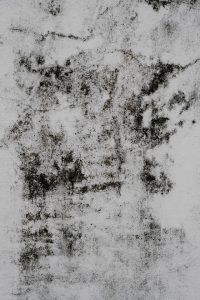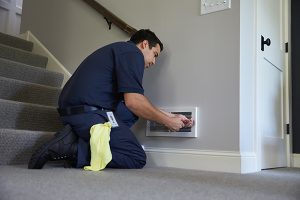A mold infestation in the bedroom is worrisome. Sleeping in a room contaminated with mold exposes householders to the harmful spores for several hours. Especially when an individual is sensitive to mold spores, sleeping in a home with mold can lead to adverse health consequences.
What is mold?
Mold spores are plentiful in the natural environment. Microscopic mold spores meander throughout the great outdoors and eat away at decaying matter, like dead leaves, trees and other organic debris. Outdoor mold is helpful. When spores land indoors, however, the mold is a harmful nuisance.
Indoor mold thrives in moist areas. A damp basement, underneath a leaky pipe or the crevices in a humid bathroom are places where mold often grows. Mold requires only moisture, oxygen and an organic food source in order to flourish. Sometimes, the bedroom provides all three.
When is the mold count highest?
Mold grows all year round in the United States. The Midwest’s severe winter months cause the spores to become dormant. However, in the high humidity and temperatures of summers in Aurora, Illinois, the spores are the most active; summer is considered the peak period for mold growth.
Can mold grow in a bedroom?
A bedroom is often seen as one of the tidiest rooms of the home. Freshly made beds, folded clothes and open windows give the bedroom a clean appearance. However, mold is stealthy and will invade any room that provides sufficient nourishment for the spores to grow.
Porous materials are a preferred food source for mold spores. Wallpaper may line the bedroom walls; ceiling tiles are installed; and insulation is added. Paper and cardboard products may be housed in the bedroom. Natural materials, like these, attract mold spores, especially when dampness is present.
Moisture problems are not always immediately evident. A homeowner may fail to notice a leaky roof, which allows moisture to accumulate in the bedroom below. The bedroom windows or water pipes may leak, permitting a disastrous moisture intrusion and subsequent mold growth.
Similarly, tossing wet clothes into a hamper or the back of a bedroom closet will provoke a mold infestation in no time. Spilling a drink on the bedroom carpet will allow mold to latch on, especially when the liquid fails to be cleaned and dried within 48 hours.
Mold spores are eager to inhabit humid spaces. An overly humid bedroom is an ideal host for mold spores. An inadequately ventilated bedroom in which condensation accumulates also draws mold. A lack of sufficient air flow, such as in closets and behind bedroom furniture, will spur a case of mold.
Why is it unsafe to sleep in a home with mold?
Mold spores can cause allergic reactions in vulnerable people. The spores can be irritating to human skin, causing redness and rashes. When inhaled or touched, mold spores can trigger common reactions, like nasal congestion, chronic cough, sneezing, red eyes and blurred vision.
People with underlying respiratory conditions and lung disease can experience severe symptoms when exposed to mold. Lung infections, shortness of breath and fever are typical. Children less than a year old may have an increased risk of developing asthma when exposed to mold.
Inhaling mold spores during sleep is also harmful. Sleep is compromised due to mold-related symptoms, such as wheezing and a runny nose. Householders may also experience increased insomnia, daytime sleepiness and snoring, which are linked with mold exposure in the home.
Mold exposure raises the likelihood that householders will develop allergic rhinitis, which is an allergy caused by breathing in mold, or other allergens, like pollen, dander and dust. A range of sleep problems, including restless sleep and obstructive sleep apnea, can result.
What are signs of mold in the bedroom?
A householder who experiences increased allergy symptoms while in the bedroom should suspect mold and look for indications of mold growth. The spores can multiply for a lengthy period of time before the growth is visible to the naked eye.
Mold can be detected by the human nose. An unusual, musty odor can point to mold growth. If condensation forms on the windows, mold will have the sustenance it needs to grow. Mold can be hidden under the wallpaper, carpeting, panels and behind the walls.
What strategies control mold in the home?
Humidity control is among the most effective ways to prevent mold growth. Humidity levels should remain between 30 and 50 percent. Switch on a dehumidifier or air conditioner in a moisture-prone bedroom. Increase ventilation in the room to prevent spores from growing.
Liquids spilled on the mattress or carpeting should be cleaned up and dried as quickly as possible to prevent mold. Shift the bedroom furniture away from the walls to permit adequate air flow. Regularly move stacks of bedding or clothing so as not to allow them to sit undisturbed.
When mold is suspected in your Aurora, Illinois, home, consult ServiceMaster S&R Systems, a professional mold remediation company, right away. Our skilled technicians will arrive promptly, assess the extent of both hidden and visible mold growth and begin the mold cleanup process.
Our mold removal techniques involve isolating the affected areas to prevent airborne spores from contaminating other rooms in the home. We also identify the moisture source causing the mold infestation and repair the leak or provide water damage restoration services. Permanently damaged materials are removed and salvageable goods are cleaned.
Attempting a DIY mold cleanup can lead to spreading the mold spores and aggravating the problem. The mold remediation experts from ServiceMaster S&R Systems, however, are experienced in carefully eliminating all traces of mold growth from properties and promoting a hygienic environment.
Improve the quality of your sleep by choosing ServiceMaster S&R Systems to clean up a mold infestation of any size from your home. Our technicians respond to emergency mold cleanup calls. We proudly serve the residential communities surrounding Aurora, Naperville and Joliet, Illinois. Call us today!




